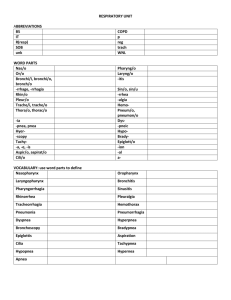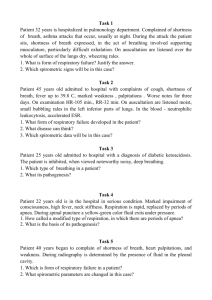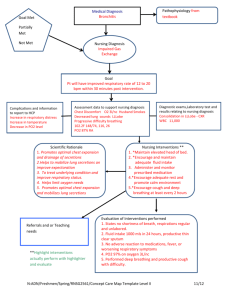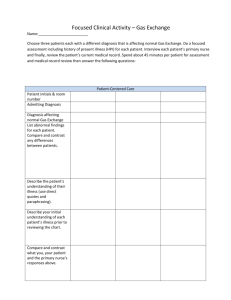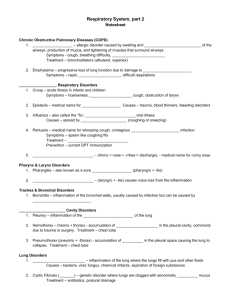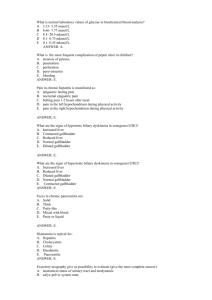Physiology lab Respiratory Breathing Lab
advertisement
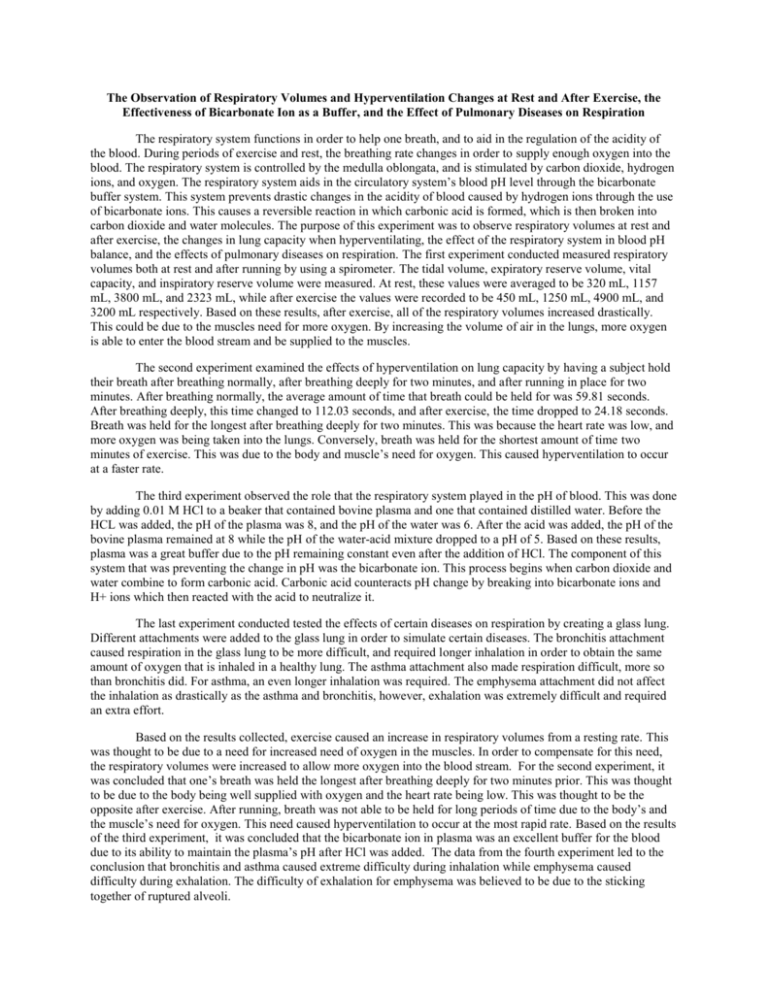
The Observation of Respiratory Volumes and Hyperventilation Changes at Rest and After Exercise, the Effectiveness of Bicarbonate Ion as a Buffer, and the Effect of Pulmonary Diseases on Respiration The respiratory system functions in order to help one breath, and to aid in the regulation of the acidity of the blood. During periods of exercise and rest, the breathing rate changes in order to supply enough oxygen into the blood. The respiratory system is controlled by the medulla oblongata, and is stimulated by carbon dioxide, hydrogen ions, and oxygen. The respiratory system aids in the circulatory system’s blood pH level through the bicarbonate buffer system. This system prevents drastic changes in the acidity of blood caused by hydrogen ions through the use of bicarbonate ions. This causes a reversible reaction in which carbonic acid is formed, which is then broken into carbon dioxide and water molecules. The purpose of this experiment was to observe respiratory volumes at rest and after exercise, the changes in lung capacity when hyperventilating, the effect of the respiratory system in blood pH balance, and the effects of pulmonary diseases on respiration. The first experiment conducted measured respiratory volumes both at rest and after running by using a spirometer. The tidal volume, expiratory reserve volume, vital capacity, and inspiratory reserve volume were measured. At rest, these values were averaged to be 320 mL, 1157 mL, 3800 mL, and 2323 mL, while after exercise the values were recorded to be 450 mL, 1250 mL, 4900 mL, and 3200 mL respectively. Based on these results, after exercise, all of the respiratory volumes increased drastically. This could be due to the muscles need for more oxygen. By increasing the volume of air in the lungs, more oxygen is able to enter the blood stream and be supplied to the muscles. The second experiment examined the effects of hyperventilation on lung capacity by having a subject hold their breath after breathing normally, after breathing deeply for two minutes, and after running in place for two minutes. After breathing normally, the average amount of time that breath could be held for was 59.81 seconds. After breathing deeply, this time changed to 112.03 seconds, and after exercise, the time dropped to 24.18 seconds. Breath was held for the longest after breathing deeply for two minutes. This was because the heart rate was low, and more oxygen was being taken into the lungs. Conversely, breath was held for the shortest amount of time two minutes of exercise. This was due to the body and muscle’s need for oxygen. This caused hyperventilation to occur at a faster rate. The third experiment observed the role that the respiratory system played in the pH of blood. This was done by adding 0.01 M HCl to a beaker that contained bovine plasma and one that contained distilled water. Before the HCL was added, the pH of the plasma was 8, and the pH of the water was 6. After the acid was added, the pH of the bovine plasma remained at 8 while the pH of the water-acid mixture dropped to a pH of 5. Based on these results, plasma was a great buffer due to the pH remaining constant even after the addition of HCl. The component of this system that was preventing the change in pH was the bicarbonate ion. This process begins when carbon dioxide and water combine to form carbonic acid. Carbonic acid counteracts pH change by breaking into bicarbonate ions and H+ ions which then reacted with the acid to neutralize it. The last experiment conducted tested the effects of certain diseases on respiration by creating a glass lung. Different attachments were added to the glass lung in order to simulate certain diseases. The bronchitis attachment caused respiration in the glass lung to be more difficult, and required longer inhalation in order to obtain the same amount of oxygen that is inhaled in a healthy lung. The asthma attachment also made respiration difficult, more so than bronchitis did. For asthma, an even longer inhalation was required. The emphysema attachment did not affect the inhalation as drastically as the asthma and bronchitis, however, exhalation was extremely difficult and required an extra effort. Based on the results collected, exercise caused an increase in respiratory volumes from a resting rate. This was thought to be due to a need for increased need of oxygen in the muscles. In order to compensate for this need, the respiratory volumes were increased to allow more oxygen into the blood stream. For the second experiment, it was concluded that one’s breath was held the longest after breathing deeply for two minutes prior. This was thought to be due to the body being well supplied with oxygen and the heart rate being low. This was thought to be the opposite after exercise. After running, breath was not able to be held for long periods of time due to the body’s and the muscle’s need for oxygen. This need caused hyperventilation to occur at the most rapid rate. Based on the results of the third experiment, it was concluded that the bicarbonate ion in plasma was an excellent buffer for the blood due to its ability to maintain the plasma’s pH after HCl was added. The data from the fourth experiment led to the conclusion that bronchitis and asthma caused extreme difficulty during inhalation while emphysema caused difficulty during exhalation. The difficulty of exhalation for emphysema was believed to be due to the sticking together of ruptured alveoli.


